Maia (20 Tauri): Star Type, Name, Location, Constellation | Star Facts (original) (raw)
Maia, 20 Tauri (20 Tau) is a blue-white giant star located in the constellation Taurus. With an apparent magnitude of 3.871, it is the fourth brightest member of the Pleiades cluster, after Alcyone, Atlas and Electra. Maia is visible to the unaided eye in good conditions. It lies at an approximate distance of 400 light years from Earth.
Maia has the stellar classification B8III, indicating a giant star appearing bluish in colour. It has more than 5 solar masses and a radius 6.04 times that of the Sun. With an effective temperature of 12,600 K, it is 850 times more luminous than the Sun, but most of its energy output is in the ultraviolet part of the spectrum. Compared to its bright Pleiades neighbours, Maia is a slow rotator, with a projected rotational velocity of 33 km/s. It is a mercury-manganese star, a chemically peculiar star with an atmospheric excess of mercury, manganese and other elements. Other relatively bright stars of this type include Alpheratz in the constellation Andromeda, Gienah in Corvus, and Muliphein in Canis Major.
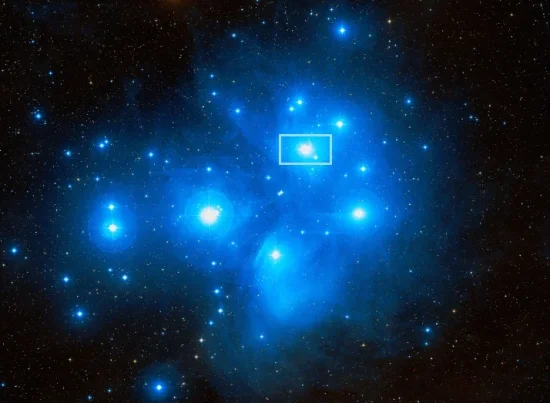
Maia (20 Tauri), image: Wikisky
Maia Nebula – NGC 1432
Maia is surrounded by a particularly bright patch of nebulosity known as the Maia Nebula and catalogued as NGC 1432. The nebula has an apparent size of 30’, which translates into a physical size of 1.6 by 1.4 light years. It was discovered by the French astronomer and optician Paul-Pierre Henry on November 16, 1885.
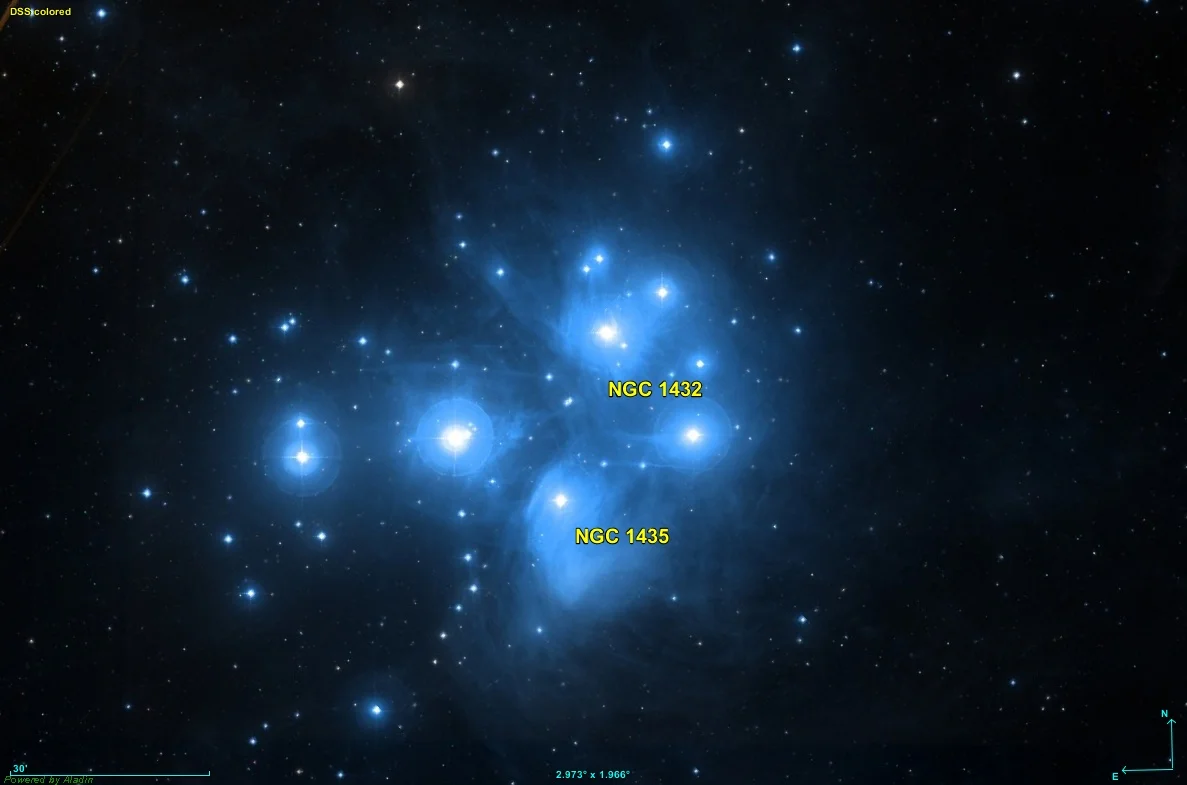
Maia Nebula (NGC 1432) and Merope Nebula (NGC 1435), image: Donald Pelletier
Pleiades
The Pleiades cluster is one of the brightest and nearest open clusters to the Sun. Its brightest members are young, luminous blue stars easily visible on a clear night, appearing as a bright bunch of grapes in the sky. These stars formed in the same molecular cloud within the last 100 million years and are moving through space together. They lie at an average distance of 444 light years from Earth. The stars are expected to keep travelling together for another 250 million years. The cluster will eventually disperse due to interactions with the interstellar medium.
The cluster was catalogued as the 45th entry in Charles Messier’s catalogue, which contains a list of 110 astronomical objects that may be confused for comets. It is unclear why the French astronomer and comet hunter included the Pleiades and several other deep sky objects that are not likely to be mistaken for comets, but as the Messier catalogue is one of the best known lists of bright deep sky objects in existence, the cluster is commonly referenced as Messier 45.
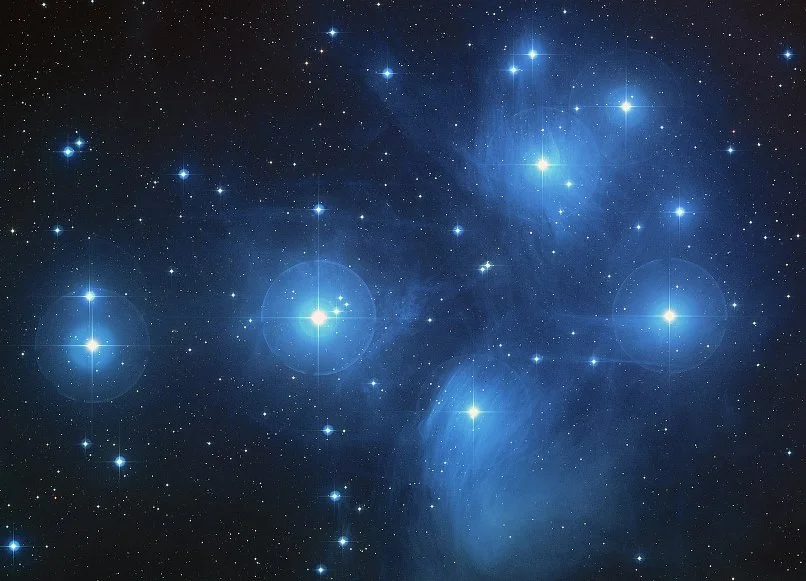
The Pleiades (M45), image: NASA, ESA, AURA/Caltech, Palomar Observatory, credit: D. Soderblom and E. Nelan (STScI), F. Benedict and B. Arthur (U. Texas), and B. Jones (Lick Obs.)
M45 contains over a thousand confirmed members and many other unresolved stars. The fainter, redder stars contribute the most to the cluster’s mass, which is estimated to be about 800 solar masses. M45 is also home to many brown dwarfs, which may constitute as much as a quarter of the cluster’s population.
The cluster stretches across 110 arcminutes of the apparent sky and has an apparent magnitude of 1.6. It is the most distinctive star cluster that can be seen without binoculars. Up to 14 stars are visible under exceptionally clear, dark skies, but observers can usually make out only six to eight members.
The nine brightest Pleiades stars are named after the Pleiades, the Seven Sisters in Greek mythology – Alcyone (Eta Tauri), Asterope (21 Tauri), Celaeno (16 Tauri), Electra (17 Tauri), Maia (20 Tauri), Merope (23 Tauri) and Taygeta (19 Tauri) – and their parents Atlas (27 Tauri) and Pleione (28 Tauri).
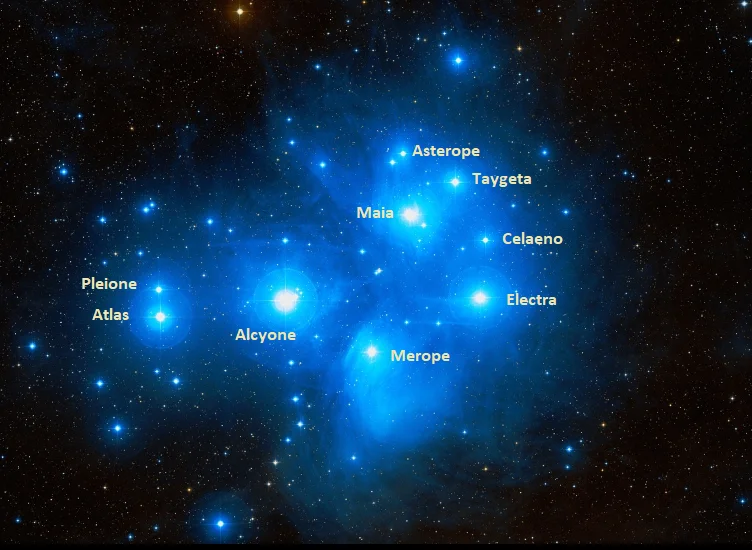
The Pleiades, image: Wikisky
In Greek lore, the sisters caught the eye of Orion, a giant huntsman, who started to pursue them after their father Atlas was forced to uphold the heavens on his shoulders. Atlas was one of the Titans who fought and lost the war against the Olympian gods and felt the consequences of defeat. Zeus saw Orion pursuing his seven daughters and, to protect them, he first turned the sisters into doves and later into stars to comfort their father. It is said that the Pleiades are still pursued by the constellation Orion across the sky.
Facts
Maia was once thought to be a variable star. In 1955, the Russian-American astronomer Otto Struve proposed the existence of a class of variable stars with periods between about 0.1 and 0.3 days and spectral types from B7III to A2 V-II. The proposed class, called Maia variables, included Pherkad, Gamma Ursae Minoris, and a number of other stars. However, some of these stars, including Maia, were later found to be stable, not variable. Struve himself withdrew his theory after concluding that Maia was not variable.
In spite of this, researchers have continued to look for short period variability in the Pleiades cluster. In 2017, an international team of researchers used a technique called “halo photometry” to detect any changes in brightness and found that seven of the cluster’s bright stars were slowly pulsating B-type stars. Maia, however, showed regular changes over a period of 10 days and, unlike the other stars, its brightness did not change due to pulsations, but due to a large chemical spot on its surface coming in and out of view as a result of rotation.
The Pleiades have been known in cultures around the world since ancient times. The earliest known record of the cluster is a depiction on the Nebra sky disk, a Bronze Age artifact discovered in Germany, dating back to around 1600 BCE. The cluster was mentioned in a number of ancient texts, including the Bible, Homer’s Iliad and Odyssey, and Hesiod’s Works and Days.
Italian astronomer and physicist Galileo Galilei was the first to observe the Pleiades through a telescope, and the first to discover that the cluster contained many other fainter stars that were invisible to the unaided eye. Galilei published his notes and a sketch of the cluster in March 1610.
In 1786, the French astronomer Edme-Sébastien Jeaurat published a map of 64 stars in the cluster.
In Japan, the cluster is known as Subaru. The automobile company of the same name uses an image of the six brightest stars in its logo. In the 8th century, the cluster was mentioned as Mutsuraboshi in Kojiki, an early compilation of Japanese oral traditions.
Name
The name Maia (pronunciation: /ˈmaɪ.ə/ or /ˈmeɪə/) comes from Greek mythology. The star was named after one of the Pleiades, the seven daughters of the Oceanid nymph Pleione and the Titan Atlas. Maia (Greek: Μαῖα) was the eldest of the seven sisters. She was the mother of Hermes, the Greek messenger of the gods.
The name was officially approved by the International Astronomical Union’s (IAU) Working Group on Star Names (WGSN) on July 20, 2016.
The Chinese know Maia as the Fourth Star of Hairy Head. Hairy Head is an asterism formed by the Pleiades stars Asterope, Atlas, Electra, Maia, Merope, Taygeta, and Alcyone. It is one of the seven mansions of the White Tiger.
Location
Maia is easy to find because it is part of one of the most prominent features of the night sky. The Pleiades cluster is easily spotted on its own because it is exceptionally bright and large, but it can also be found by extending an imaginary line from the three stars of Orion’s Belt – Alnitak, Alnilam and Mintaka – past Aldebaran, the brightest star in Taurus. The cluster lies about 14 degrees northwest of the star.
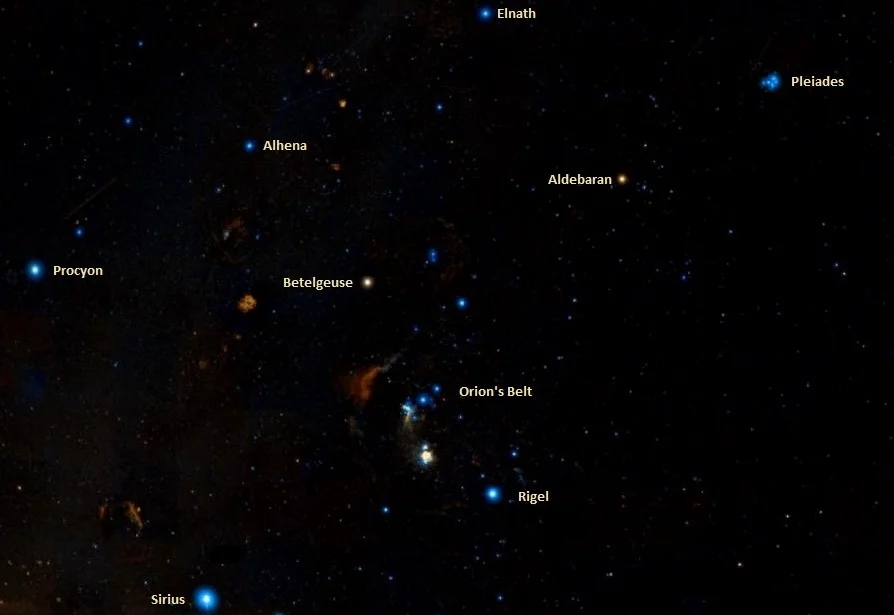
Pleiades location, image: Wikisky
The Pleiades can be seen rising prominently in the sky from October to April. The cluster is invisible during the months of May and June, when it is too close to the Sun.
Constellation
Maia is located in the constellation Taurus, the Bull. Taurus is one of the largest northern constellations, stretching across an area of 797 square degrees. Known for being home to Aldebaran, the 14th brightest star in the sky, and the two bright, large open clusters – the Pleiades and the Hyades – Taurus is also one of the most recognizable constellations. The Hyades cluster outlines the V-shape of the Bull’s head, while the bright Aldebaran, appearing as the cluster’s brightest member even though it is not, marks the Bull’s eye.
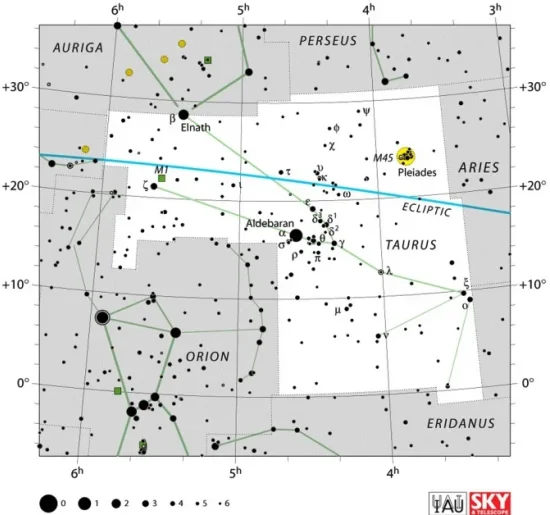
Taurus constellation map by IAU and Sky&Telescope magazine
Taurus contains several other interesting deep sky objects. The best known ones are the Crab Nebula, catalogued as Messier 1, a bright remnant of a historic supernova, the planetary nebula NGC 1514, also known as the Crystal Ball Nebula, and the reflection nebula NGC 1555, named Hind’s Variable Nebula because its brightness varies due to being illuminated by the young variable star T Tauri. Other relatively bright deep sky objects in the constellation include the supernova remnant known as the Spaghetti Nebula (Sh2-240, Simeis 147), the open clusters NGC 1647 and NGC 1817, and the colliding galaxy pair NGC 1409 and NGC 1410.
The best time of year to observe the stars and deep sky objects in Taurus is during the month of January.
The 10 brightest stars in the constellation are Aldebaran (Alpha Tau, mag. 0.86), Elnath (Beta Tau, mag. 1.65), Alcyone (Eta Tau, mag. 2.87), Tianguan (Zeta Tau, mag. 2.97), Chamukuy (Theta2 Tauri, mag. 3.40), Lambda Tauri (mag. 3.47), Ain (Epsilon Tau, mag. 3.53), Omicron Tauri (mag. 3.61), Atlas (27 Tau, mag. 3.63), and Prima Hyadum (Gamma Tau, mag. 3.654).
Maia – 20 Tauri
| Spectral class | B8III |
|---|---|
| Variable type | Suspected |
| U-B colour index | -0.40 |
| B-V colour index | -0.07 |
| Apparent magnitude | 3.871 |
| Absolute magnitude | -1.69 |
| Distance | 400 light years (120 parsecs) |
| Parallax | 8.2 ± 1.03 mas |
| Radial velocity | 7.5 km/s |
| Proper motion | RA: 21.09 mas/yr |
| Dec.: -45.03 mas/yr | |
| Mass | >5 M☉ |
| Luminosity | 850 L☉ |
| Radius | 6.04 R☉ |
| Temperature | 12,600 K |
| Metallicity | 1.10 Fe/H |
| Rotational velocity | 33 km/s |
| Constellation | Taurus |
| Right ascension | 03h 45m 49.6067s |
| Declination | +24° 22′ 03.895″ |
| Designations | Maia, 20 Tauri, 20 Tau, HD 23408, HR 1149, HIP 17573, GC 4500, GCRV 2097, SAO 76155, NSV 1279, BD+23°516, WDS J03458+2422A, PPM 92841, IRAS 03428+2412, 2MASS J03454960+2422037, TYC 1799-1439-1, Gaia DR2 65283232318680704 |